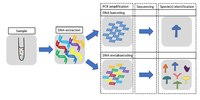
Photo from wikipedia
Abstract Marinas are high-priority targets for marine non-indigenous species (NIS), where they compose a large portion of the biofouling communities. The practicality of water samples collection makes environmental DNA (eDNA)… Click to show full abstract
Abstract Marinas are high-priority targets for marine non-indigenous species (NIS), where they compose a large portion of the biofouling communities. The practicality of water samples collection makes environmental DNA (eDNA) metabarcoding an interesting tool for routine NIS surveys. Here the effectiveness of water-eDNA-metabarcoding to identify biofouling NIS, in 10 marinas from western France, was examined. Morphological identification of specimens collected in quadrats brought out 18 sessile benthic NIS beneath floating pontoons. Water-eDNA-metabarcoding detected two thirds of them, failing to detect important NIS. However, sampling and bioinformatics filtering steps can be optimized to identify more species. In addition, this method allowed the detection of additional NIS from neighboring micro-habitats. Caution should, however, be taken when reporting putative novel NIS, because of errors in species assignment. This work highlights that water-eDNA-metabarcoding is effective for active (targeted) NIS surveys and could be significantly improved for its further use in marine NIS passive surveys.
Journal Title: Biofouling
Year Published: 2022
Link to full text (if available)
Share on Social Media: Sign Up to like & get
recommendations!